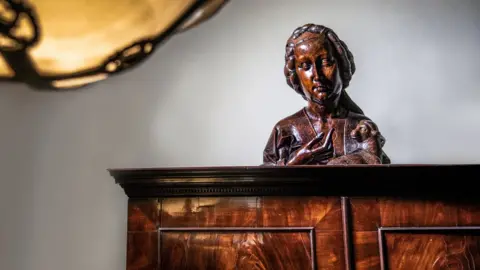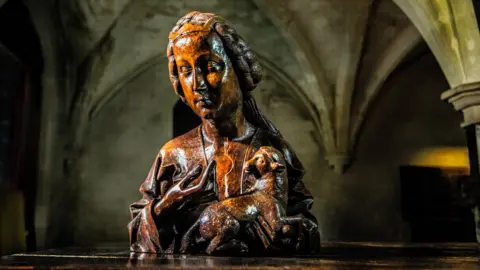Rare sculpture found on top of cupboard at Anglesey Abbey
 National Trust/Rah Petherbridge
National Trust/Rah PetherbridgeA sculpture that was sat on top of a cupboard in a National Trust property has been identified as a rare 15th Century work of art.
Researchers said the bust of St Agnes was created by the sculptor Niclaus Gerhaert von Leyden or his workshop.
Only 20 of his works are believed to have survived and the newly-discovered sculpture is thought to be his only work in a public collection in the UK.
The life-sized bust was discovered at Anglesey Abbey in Cambridgeshire.
St Agnes was one of the first women venerated in the Roman Catholic Church's hierarchy of saints and was said to have been martyred aged 12 as she refused to marry the son of a Roman official.
The sculpture of St Agnes was carved from walnut and dates back to about 1465, the National Trust said.
Its creator, Gerhaert, worked in northern Europe and has been considered as one of the most important and influential artists of the Gothic period, a spokeswoman for the trust said.
 National Trust/Rah Petherbridge
National Trust/Rah PetherbridgeThe discovery was part of the National Trust's four-year cataloguing project to research and record all 6,000 sculptures and statues in its collection.
The sculpture of the martyr St Agnes came into the National Trust's collection between 1932 and 1940, a spokeswoman said.
It was purchased by the owner of Anglesey Abbey, Lord Fairhaven, but was wrongly described in a 1940 inventory as "The Virgin and the Lamb" and was displayed on top of a cupboard in the Windsor Bedroom for many years.
The National Trust's sculpture research curator Dr Jeremy Warren discovered the true identity of the walnut bust.
"It was clear to me that the sculpture was of superb quality, with enough clues to lead us to look at the work of sculptors who were working in the later 15th Century," he said.
"My research took me to the surviving plaster cast of this bust, which tied up all the loose ends neatly. It has taken over 80 years for St Agnes to be given back her identity."
The bust of St Agnes will be on display in the dining room of Anglesey Abbey until the spring.
